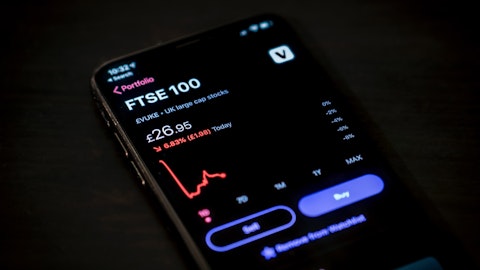Highwoods Properties, Inc. (NYSE:HIW) Q3 2023 Earnings Call Transcript October 25, 2023
Operator: Hello, and welcome to the Highwoods Q3 2023 Earnings Call. My name is Alex. I’ll be coordinating the call today. [Operator Instructions] I’ll now hand over to your host Brendan Maiorana, CFO, to begin. Please go ahead.
Brendan Maiorana: Thank you, operator, and good morning, everyone. Joining me on the call this morning are Ted Klinck, our Chief Executive Officer; and Brian Leary, our Chief Operating Officer; Hannah True, our Manager of Finance and Corporate Strategy is under the weather. For your convenience, today’s prepared remarks have been posted on the web. If you have not received yesterday’s earnings release or supplemental, they’re both available on the Investors section of our website at highwoods.com. On today’s call, our review will include non-GAAP measures such as FFO, NOI and EBITDAre. The release and supplemental include a reconciliation of these non-GAAP measures to the most directly comparable GAAP financial measures. Forward-looking statements made during today’s call are subject to risks and uncertainties.
These risks and uncertainties are discussed at length in our press releases as well as our SEC filings. As you know, actual events and results can differ materially from these forward-looking statements and the Company does not undertake a duty to update any forward-looking statements. With that, I’ll turn the call over to Ted.

An aerial view of a city skyline, its buildings glittering in the sunlight, reflecting the company’s focus on real estate investments. Editorial photo for a financial news article. 8k. –ar 16:9
Ted Klinck: Thanks, Brendan, and good morning, everyone. During the third quarter, we once again had solid financial and operational results, while maintaining a balance sheet is among the strongest in the sector with healthy credit metrics and ample liquidity. At the beginning of the year, we predicted the operating environment in capital markets, particularly for the office sector, would remain challenged for an extended period of time. So far, this is playing out as expected. We remain laser-focused on operations and balance sheet management and believe the meaningful new investment opportunities will eventually surface. With this backdrop, these are our priorities. First, ensuring our portfolio operations remain healthy.
To that end, we’re aggressively addressing future lease role, proactively reinvesting in those assets with ample opportunity to drive outsized returns, focusing on net effective rents and maintaining strong cash flow by being even more disciplined on discretionary CapEx. Second, continuing to sell non-core assets. Obviously, this is currently challenging, but we continue to believe there will be ready, willing, enable buyers for stabilized assets, especially bite-size deals. Third, further bolstering our already strong balance sheet by increasing liquidity. And finally, canvassing our markets for future growth opportunities. We firmly believe having a high-quality, resilient portfolio in the best markets and BBDs in the SunBelt and the balance sheet strength to weather this capital-constrained environment, positions us well to capitalize on long-term growth opportunities that will inevitably come with the next cycle, even if this current cycle lasts several more years.
Turning to the quarter. We delivered FFO of $0.93 per share and grew same-property cash NOI 2%. We signed 655,000 square feet of second-gen leases, 19% lower than our trailing five-quarter average. With a steady, albeit modest increase in the return to office across our customer base since Labor Day, we’re off to a solid start with our leasing volume so far in the fourth quarter. Our net effective rents continue to be resilient as our year-to-date average is on pace to surpass our prior high watermark and exceed 2019 by 5%. While rent spreads garner more headlines, we have long believed it’s more important to measure leasing performance by considering the entirety of lease economics. We’re pleased net effective rents have remained strong, a direct result of the flight to quality, not just the flight to quality assets but also flight to quality owners who have access to capital.
Our sponsorship is a true differentiator when companies are making leasing decisions, and this has only become more important since the pandemic. I want to provide an update on the former Tivity building in Nashville. Last year, we substantially backfilled the building by signing a 223,000 square foot lease with a single customer that currently leases 50,000 square feet in another Highwoods building. Unfortunately, since that lease execution, this customer has experienced some challenging and unforeseen business conditions that are impacting their growth plans and cash flow. We are currently in discussions with our customer about what makes the most sense going forward for both Highwoods and for them. It’s possible we may ultimately decide it’s in our best long-term interest to modify their lease, which is scheduled to commence in early 2024.
The quarter was quiet on the investment front. We completed three development projects with a total projected investment of $234 million, at our share, that were a combined 30% pre-leased. 2827 Peachtree is 88% pre-leased, and we have an LOI to bring the property to 92%. The other two projects, GlenLake III in Raleigh and Granite Park Six in Dallas aren’t projected to stabilize until 2026. We signed a 20,000 square foot lease of Midtown East in Tampa, and we’re seeing additional strong interest in this development, which isn’t scheduled to be completed until early 2025 and stabilized until mid-2026. At 23Springs, our 642,000 square foot tower in Uptown Dallas, we have LOIs over pre-leased rate to over 50%. While we didn’t close any dispositions during the quarter, we’ve remained active marketing additional non-core properties for sale.
The current environment is obviously challenging, but we’re cautiously optimistic we’ll close a few smaller deals in the coming months. We’ve been quiet on acquisition and development announcements this year. I mentioned earlier, we believe there will be significant opportunities in the future. We’re consistently in discussions with owners of wishlist assets across our footprint. Lenders are generally being patient with owners, but there is stress in the system, and it will take time for these future opportunities to arise. Our 2023 FFO outlook is unchanged at the midpoint. The steadiness of this year’s FFO outlook masks better-than-anticipated NOI being offset by higher interest expense. To that end, we increased the midpoint of our same-property cash NOI outlook to a revised range of 0% to plus 1%.
Before I turn the call over to Brian, I’d like to summarize why we are optimistic about the future at Highwoods. The office business as a whole is under stress, leasing, portfolio metrics, cash flows, access to capital, et cetera. But during periods of stress, the best positioned companies rise to the top and eventually thrive. We’re well positioned to capitalize on dislocations in the office sector. Our high-quality SunBelt portfolio is located in the best markets and BBDs. Our balance sheet is among the strongest in the sector, and our team is cycle-tested and excited about the future opportunities that will arise. Brian?
Brian Leary: Thank you, Ted, and good morning, everyone. Our leasing team was active for the quarter with our largest four markets, each signing over 100,000 square feet. In the aggregate, we signed over 655,000 square feet to continue the trend of expansions outnumbering contractions 3:1 for the quarter, 73% of leasing activity for the quarter and 60% year-to-date occurred in our suburban BBDs. We believe this supports our simple and steadfast strategy of delivering commute-worthy workplace experiences in both urban and suburban best business districts. Our 16% payback was the lowest since the third quarter of 2022, while free rent was only 4.3% of the cash term, the lowest ratio since the third quarter of 2020. As Ted mentioned, these strong leasing economics translated into healthy net effective rents trending above our pre-pandemic average.
While we are seeing the cyclical demand headwinds of a lower growth environment, Labor Day mark the next phase of return to the office initiatives, an uptick in physical occupancy with insurance, financial services and telecom leading activity for the quarter. Now let’s turn to our markets, and in particular, the Sunshine state, where our team in Tampa had the highest volume in the quarter with 150,000 square feet signed, and our Orlando portfolio ended the quarter over 92% occupied. CBRE highlighted that the Tampa market saw positive net absorption for the third consecutive quarter and is on pace to have the best year for positive absorption since 2017. Vacancy is down, and there are 2 million square feet of prospects looking for space. Office employment growth remains well above the national average with the Tampa metro ranking first in Florida for year-over-year job growth.
As the only new building under construction in the market, Midtown East, our 83,143,000 square foot development in the Westshore BBD is seeing good inbound activity as evidenced by the recently signed 20,000 square foot new customer to our Tampa portfolio there. This follows our successful completion and lease-up of our 152,000 square foot Midtown West building now 100% occupied at rents above our underwriting. In North Carolina, our Raleigh team signed 144,000 square feet in the quarter, and the overall market achieved 248,000 square feet of positive net absorption according to CBRE. We completed our 218,000 square foot GlenLake III mixed-use development on time and on budget which brings our total GlenLake development to nearly 1 million square feet.
Prospect activity is picking up with the ability to tour the space and amenities. We estimate stabilization in early 2026. Down I-85 in Charlotte, our 2 million square foot portfolio is now 95.6% occupied and 97.8% leased. Last year, and adjacent to our 33-story Bank of America Tower we acquired 650 South Tryon, a 367,000 square foot building that was 79% leased upon acquisition and is now 94% leased. The overall market is seeing healthy activity, including continued inbound corporate relocations and is underexposed to sublease availability compared to other markets with equal amounts of space being leased and added to the market in recent quarters according to JLL. The Atlanta team was also busy in the third quarter with 127,000 square feet signed, and subsequent to quarter end, in an additional 50,000 square feet at Two Alliance and Buckhead, bolstering the backfill of Novelis’ Q3 2024 expiration.
2827 Peachtree, our 135,000 square foot development in Buckhead was delivered on time and on budget at 88.4% pre-leased and is expected to stabilize well before our pro forma stabilization date of early 2025. We believe the quarter’s overall leasing stats bear out our simple strategy and resilient portfolio, if even across lower-than-average leasing volume. We continue to witness the evolving consensus between managers and workers on when and where they will be better together. To this point, there are real-time evolutions across the portfolio where customers previously entertained subleasing, then signal the downsize to then ultimately renew at a 100% of their existing footprint. Self-performing our leasing, property management and maintenance across the majority of the portfolio has given us a unique position to increase the breadth and depth of our customer relationships through the pandemic and into today’s choppy waters.
Our relative performance to our markets and within our BBDs is bearing witness to this under one roof approach. We will remain proactive in addressing our future lease roll, are committed to delivering meaningful new revenue via our development pipeline and believe our continued ability to create commute-worthy workplaces yields a resilient portfolio and one positioned to thrive in the future. Brendan?
Brendan Maiorana: Thanks, Brian. In the third quarter, we delivered net income of $22.1 million or $0.21 per share and FFO of $99.8 million or $0.93 a share. Results were in line with our expectations with no significant unusual items. There wasn’t much of a change from the second quarter with overall FFO down $0.01 sequentially. The slight change was driven by modestly lower NOI attributable to higher OpEx and the full quarter impact of dispositions completed in the second quarter and higher interest expense. Our cash flows continue to exhibit resilience even in the face of higher interest rates. We’ve been highlighting the benefits of our asset recycling program for a few years, but in a year when challenges are more apparent, these benefits become more obvious.
So far this year, we’ve invested over $115 million in our development pipeline while receiving only $40 million of net disposition proceeds and another $40 million from the repayment of our preferred equity investment in our McKinney & Olive joint venture. Said differently, we’ve been a net investor monetizing income-producing assets while investing in development that isn’t yet providing NOI, while holding our debt-to-EBITDA metrics flat at 6x and keeping our overall debt balance essentially unchanged at $3.2 billion. And this doesn’t count the approximate $40 million of NOI, we expect to garner upon stabilization of the development pipeline. In addition to maintaining strong leverage metrics, we further strengthened our liquidity throughout the year.
As disclosed in last evening’s press release, our Midtown West joint venture closed a five-year mortgage for $45 million at a fixed interest rate of 7.29%. The net proceeds received from the joint venture were used to pay down our credit facility. This further improves our current liquidity which is now over $770 million and gives us ample dry powder to fund our $270 million of remaining development expenditures. Since the beginning of the year, we proactively increased our total available liquidity by over $200 million while reducing future investment obligations by $100 million. Our healthy current liquidity, combined with limited near-term debt maturities provides us flexibility, and we do expect additional disposition proceeds in future quarters.
However, as mentioned last quarter, we may be opportunistic to raise additional debt capital later this year or next. As Ted mentioned, we’ve updated our outlook with no change to the midpoint of our FFO range which is now $3.73 to $3.77 per share. Given our performance to date this year, we revised our same-property cash NOI outlook upward to 0% to plus 1%. All other outlook line items that impact FFO are unchanged, but I will note we expect to be towards the low end of the year-end occupancy range. As we’ve mentioned before, this is a challenging metric to forecast given it’s a point estimate on the last day of the year. A couple of items to keep in mind for the fourth quarter. First, we expect lower operating margins due to pushing some discretionary OpEx late into the year.
And second, interest expense is expected to increase due to higher average SOFR rates in the new fixed rate mortgage at Midtown West. Finally, as you know, we plan to provide our 2024 outlook in February when we release our fourth quarter results. In the interim, there are some items I would like to highlight. First, operating margins in future years may move closer to our pre-pandemic average as we absorb the impact of higher inflation across major OpEx line items and portfolio utilization increases. Second, we may be opportunistic raising additional debt capital, which would likely result in higher interest expense. Finally, we are optimistic that we’ll close additional dispositions over the next few months which would likely be a headwind to FFO in the short term, though could be a net benefit to cash flow.
In summary, we’re encouraged by the resilience of our portfolio and cash flows have exhibited in 2023 and over the past few years, and we’re excited about the future. We have the right portfolio, balance sheet and team to weather the current environment and excel once the cycle turns. Operator, we are now ready for questions.
See also 12 Most Expensive Restaurants In the World and Top Investors’ Stock Portfolio: 10 Small-Cap Stocks To Buy.
Q&A Session
Follow Highwoods Properties Inc. (NYSE:HIW)
Follow Highwoods Properties Inc. (NYSE:HIW)
Operator: [Operator Instructions] Our first question for today comes from Camille Bonnel from Bank of America. Your line is now open. Please go ahead.
Camille Bonnel: Retention in your portfolio overall seems healthy, but leasing volumes continue to slow. I imagine the general economy is weighing on this decision-making process, but can you talk to what you’re seeing from your conversations with tenants, for companies who had relocation plans to set up hubs in your markets, are you seeing them start to pull back and focus more on their coastal HQs?
Ted Klinck: Good morning, Camille, it’s Ted, and I can start and if Brian has anything to add. Look, I think general leasing, we continue to have steady tour activity, certainly post Labor Day. I think the biggest thing for us that we’re seeing is the decision-making has just been delayed. It’s just taking longer. So I think the CEOs are seeing they’re having some hesitation, just the general economic backdrop the environment we’re in. We actually did lose a couple of deals that we thought we were going to get done and the CEO ended up pulling back and end up doing some short-term renewals just to sort of wait out the current economic situation. So, we continue to see inbound. You mentioned new companies come to our markets. We had 10 new — signed 10 leases with new inbound customers who are owning up small hubs in our markets across really five different markets. So, we continue to see that in migration, but the decision-making is definitely taking longer.
Brian Leary: Camille, Brian here, one little add-on to Ted, which was the very last point of your question, are we getting a sense that folks are maybe changing their enthusiasm and momentum on the SunBelt kind of relocation or posting and retrenching back to coastal headquarters. I would say the answer is no. Just in general, there are still even relocations occurring. We’ve seen it in Charlotte, relocating out of gateway. We see it in Dallas continue. These are corporations moving their whole operations, not just hub, so just that reversion to the mean has not occurred yet.
Camille Bonnel: Okay. And on Tivity, appreciate it’s still a developing situation. But what’s the likeliness that they remain in the same office footprint? Or do you see risk of them potentially downsizing?
Ted Klinck: Yes, Camille, again, it’s very early. So look, they’ve been a good customer of ours for a few years. They started out with us at 25,000 feet and quickly grew to 50,000 feet. So, it’s a very fast-growing company. And so, I think it’s still fluid, the situation. So hopefully, we’ll have more. We’ve met with them a couple of times, understand their business and the situation they’re in. And hopefully, we’ll have more to report in the coming months.
Camille Bonnel: Okay. And final question. You’ve termed out the balance sheet well. So can you provide a latest update on your thoughts around how you’re thinking about managing your variable rate exposure, if we present in this higher rate environment?
Brendan Maiorana: Camille, it’s Brendan. So, I’ll take that. So what I would say is I think the strategy would be to do what we’ve done this year, which is focused more on improving our liquidity. So, we’ve increased liquidity by $300 million proactively throughout this year. Now, $100 million of that got used up by some through development, so the net liquidity improvement from the beginning of the year to now is up $200 million. And I think we will focus on continuing to improve that liquidity and push out any near-term debt maturities, which we don’t have for two years, but that would be the focus. I would say, over worrying about kind of floating versus fixed exposure. However, with all of that, I would say that the capital raising probably opportunities are more on the fixed rate side than the variable rate side.
So, I do think that you will see variable rate continue to migrate downward. But really, our focus would be to increase current liquidity as opposed to focusing more on fixed versus variable.
Operator: Thank you. Our next question comes from Michael Griffin of Citi. Your line is now open. Please go ahead.
Avery Tiras: This is Avery Tiras on for Michael Griffin. Just wondering if you can expand on the JV’s decision to close on the Midtown West mortgage? And just generally, how are you thinking about encumbrances as a percent of the asset pool or NOI? I mean, clearly, Highwoods well in compliance with its covenants. So wondering if you could see you continue to tap the secured debt market and just how you balance that versus drawing on your line of credit? And I guess if you have a floor on encumbrances as a percent of NOI or debt?
Brendan Maiorana: It’s Brendan. I’ll take that. So yes, I think as is typical with a JV, right, I think they — our partner would like to put some financing, some longer-term permanent financing beyond the construction facility on that building. And given the success that we had at that building, it is 100% occupied. NOI is above pro forma. So, it’s a very good fact pattern on a building that we started spec in late 2019 and leased up throughout COVID. There was — we made the decision with our partner to go ahead and put a five-year mortgage on that. So that was an easy decision, and that’s a lot of capital that gets repatriated back to Highwoods, so it improves our liquidity overall. I would say with the second part of your question, is there additional room to do secured financing over unsecured?
There probably is, but I would say that, that probably isn’t our preference, I think, where we stand now. So we’re in the mid-80s in terms of our unsecured NOI. And while we could probably move that number a little bit, I think our preference would be to look for sources of capital on the unsecured pool as opposed to the secured pool.
Avery Tiras: That makes sense. And my follow-up question is just on sublease space. So in the past few quarters, you’ve talked about some larger space takers. I believe you talked about AT&T last quarter basically pulling sublease space they had put on the market originally given just these renewed space requirements resulting from return to office mandate. So just wondering if you’re seeing any additional examples of this and just generally how sublease faring in your SunBelt markets?
Brian Leary: Avery, Brian here. I’ll take this one. So look, there’s still from a national standpoint, high watermark for subleasing kind of coast to coast. We have seen the addition of subleasing in our submarkets level off. We’ve seen it actually decrease across kind of within our own portfolio of folks doing that. So for your exact example from last quarter, we had another one who had it on the submarket. Then they talked about downsizing I mentioned in my prepared remarks, and they came back and renewed for the full amount. Not in one of our buildings, but a nice print in Tampa, Mitsubishi, United Finance Group opened 80,000 square foot offices, opening 80,000 square foot office in sublease space in Tampa’s Westshore market.




